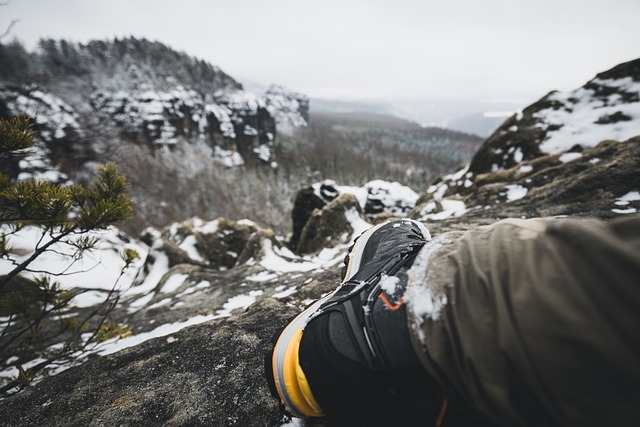Are you ready to embark on a thrilling winter adventure? The snow-capped mountains calling your name, the crisp air tingling your cheeks, and the excitement of conquering new trails. But wait, there’s a question that often pops up in our minds – are our trusty hiking boots up for the challenge?
Yes, hiking boots can be good for snow, but their suitability depends on the snow conditions and the intensity of your winter adventure. In light to moderate snow, hiking boots with ankle support and breathability can perform well. With proper adjustments like gaiters and traction devices, they can handle mixed terrains too. However, for deep snow and extreme cold, specialized snow boots with insulation and superior traction are recommended for maximum comfort and safety.
That’s the short answer but there’s much more. Get ready to uncover some snowy secrets!
Understanding Hiking Boots
before I delve into the snowy realm, let’s take a quick look at what makes hiking boots so special. If you’re like me, you probably have a favorite pair that’s seen you through thick and thin. Hiking boots are purpose-built to provide the ultimate support, protection, and comfort during your outdoor escapades.
These rugged wonders come in various styles, from low-cut trail shoes to mid-cut and high-cut boots, each designed to cater to different hiking preferences and terrains. They’re equipped with features like sturdy outsoles for grip, cushioned midsoles for shock absorption, and durable uppers to shield your feet from rocks and debris.
When you’re trekking through forests, crossing streams, or conquering rocky paths, hiking boots are the champions that keep your feet happy and protected. But the real question is, can they perform the same magic in the snow? Let’s find out!
Hiking Boots vs. Snow Boots: The Battle Begins!
The epic showdown – hiking boots versus snow boots! So, what’s the deal with these two contenders? Well, let’s break it down!
Hiking Boots: These trusty companions are like the all-rounders of the outdoor world. They excel on dry trails, handle rough terrain like champs, and offer fantastic ankle support. With their breathable materials, they help keep your feet cool and comfortable on those warm hikes.
But how do they fare in the snowy realm? Hiking boots do have some winter-ready qualities that make them a viable option for snow adventures. They often come with water-resistant or waterproof features to fend off light snow and moisture. Plus, their sturdy soles provide decent traction, which is essential when navigating icy patches.
Snow Boots: Now, let’s talk about dedicated snow boots. As the name suggests, they are specially designed to tackle winter’s challenges head-on. These babies are like cozy cocoons for your feet, providing excellent insulation and warmth to battle the chilly elements.
Their outsoles are heavily lugged, offering exceptional grip on snowy, slushy, and icy terrains. With high-cut designs, they keep snow out of your boots and maintain your tootsies toasty even in freezing conditions.
So, which one wins the battle? Well, it depends on the nature of your snowy adventure!
For light snow and mixed terrains, your reliable hiking boots can still be your go-to. They offer the advantage of versatility, especially if your winter hikes include various terrains or a mix of snow and dry paths. Just make sure to prepare them with some winter-friendly adjustments!
However, if you’re expecting deep snow, frigid temperatures, and icy surfaces, it’s time to bring in the heavy artillery – snow boots! Their superior insulation and specialized traction will provide the ultimate comfort and safety for those extreme winter conditions.
But even if you only own hiking boots, with a few smart tricks and gear additions, you can still make them winter-ready. Let’s see how you can make your hiking boots conquer the snow-covered landscapes.
The Advantages of Hiking Boots in Snowy Terrain
Believe it or not, your trusty hiking boots do have some cool tricks up their sleeves when it comes to snowy terrain. Let’s unveil the advantages that make them snow-worthy champions!
- Ankle Support and Stability: One of the significant perks of hiking boots is their sturdy construction, especially in the ankle area. When trekking on uneven, snow-covered ground, having that extra ankle support can be a real game-changer. It helps prevent twisted ankles and ensures you maintain your balance on slippery surfaces. So, you can confidently trudge through the snow with a steady stride.
- Breathability to Keep Feet Dry: Hiking boots are designed to let your feet breathe even during strenuous hikes. This breathability can be a blessing in the snow, where your feet might sweat due to the exertion and then freeze in the cold. The ability to release moisture can keep your feet dry and comfortable, reducing the risk of blisters and frostbite.
- Versatility for Mixed Terrain: Winter hikes can be unpredictable, with patches of snow, icy sections, and even dry spots along the way. Hiking boots are versatile enough to handle these mixed terrains. You don’t need to worry about switching footwear when the trail transitions from snow to rocks or dirt. Hiking boots offer a balanced combination of traction and stability that keeps you going strong, regardless of the terrain.
- Familiarity and Comfort: There’s nothing quite like slipping into a pair of well-worn hiking boots that have molded to the shape of your feet. When you’re braving the cold and trekking through the snow, having that familiar comfort can make a significant difference. You won’t have to worry about breaking in a new pair of snow boots; your hiking boots are already your old pals, ready to embark on snowy adventures with you.
- Cost-Effectiveness: If you’re an avid hiker, chances are you already have a reliable pair of hiking boots. Investing in another pair of specialized snow boots can be a hit on your wallet. So, the advantage of using your hiking boots in the snow is not just about performance but also about being budget-friendly and practical.
Remember, though, while hiking boots have their advantages in the snow, it’s crucial to assess the conditions and the depth of the snow you’ll be facing. For light or moderate snowy hikes, your hiking boots can be your snow champions. But as the snow gets deeper and the temperatures plummet, you might want to consider snow boots or suitable winter footwear for the ultimate winter wonderland experience.
Tackling the Snow: Tips for Making Hiking Boots Snow-Worthy
Ready to turn your trusty hiking boots into snow conquerors? Let’s do it! With a few nifty tricks and gear additions, we can gear up our boots to face the winter wonderland like seasoned pros. Here are some tips to make your hiking boots snow-worthy:
- Gaiters for Added Protection: Gaiters are like magic shields for your lower legs and boots. They keep snow, slush, and debris from finding their way inside your boots, ensuring your feet stay dry and cozy. Simply strap on a pair of gaiters over your hiking boots, and you’re all set for a snow-taming adventure.
- Waterproofing Agents for Repelling Moisture: To give your hiking boots that extra edge against the snow, consider applying a waterproofing treatment. Waterproof sprays or waxes create a protective barrier, preventing water and snow from seeping into the boots. Make sure to choose a product compatible with your boot material and follow the instructions for application.
- Insulating Insoles for Warmth: To battle the winter chill, consider investing in insulating insoles. These cozy inserts provide an extra layer of warmth, keeping your feet toasty even in frosty conditions. Swap out your regular insoles with insulated ones, and your feet will thank you during those chilly hikes.
- Thick, Moisture-Wicking Socks: Choosing the right socks is essential for winter hikes. Opt for thick, moisture-wicking socks to keep your feet dry and insulated. Avoid cotton socks, as they tend to retain moisture, leading to cold and uncomfortable feet. Merino wool or synthetic materials are excellent choices for winter sock bliss.
- Traction Devices for Slippery Surfaces: While hiking boots offer decent traction, sometimes the snow and ice can be a bit too tricky to handle. Fear not! You can easily attach traction devices like microspikes or crampons to your boots. These gadgets provide extra grip, keeping you stable on icy patches and steep slopes.
- Toe Warmers or Heated Insoles: For those frosty mornings and icy evenings, consider using toe warmers or battery-operated heated insoles. These little wonders provide targeted warmth to your toes, making those freezing moments a thing of the past. Say hello to cozy toes, even in the coldest of conditions!
Remember, each winter adventure may present unique challenges, so assess the weather and terrain before making adjustments to your hiking boots. These snow-worthy tips will definitely enhance your boots’ performance, making them reliable companions in the snow.
Limitations of Hiking Boots in Deep Snow
Alright, it’s time to face the truth – while hiking boots can be versatile winter companions, they do have their limitations, especially when it comes to dealing with deep snow. Let’s be real and explore some of these challenges:
- Insufficient Insulation: Hiking boots, despite their many strengths, may lack the level of insulation needed for extreme cold and deep snow conditions. Unlike dedicated snow boots, hiking boots might not provide the same level of warmth, which can lead to discomfort and even cold-related issues in frigid temperatures.
- Limited Waterproofing: While many hiking boots come with water-resistant features, they are not always fully waterproof. When faced with deep snow, prolonged exposure may eventually lead to moisture seeping into your boots. Wet feet in the snow are no fun, and it can even be dangerous in sub-zero temperatures.
- Less Specialized Traction: Hiking boots have decent traction for regular trails, but they may not always handle icy or heavily packed snow as well as specialized snow boots with aggressive, deep lugs. This can make navigating slippery surfaces more challenging and potentially increase the risk of slipping and falling.
- Potential Cold Spots: Deep snow can accumulate on the top of your hiking boots, especially if they are not high-cut. When snow enters your boots, it can create cold spots and even dampen your socks, leading to discomfort and a higher risk of frostbite.
- Difficulty in Snowshoe Compatibility: If you plan on using snowshoes for deep snow trekking, some hiking boots may not be fully compatible. Snowshoes often require specific types of boots with proper stiffness and support to work effectively. Hiking boots may not provide the ideal platform for snowshoe bindings, impacting your overall snowshoeing experience.
- Heavier and Slower Movement: Deep snow can be quite demanding on your body, requiring more effort and energy to move through it. Hiking boots, although offering ankle support, may be heavier and less flexible compared to lighter snow boots or specialized winter footwear. This extra weight and limited flexibility can lead to slower progress and more fatigue during your snowy adventures.
Now, don’t get disheartened! Remember, hiking boots still have their advantages in light or mixed snow conditions. It’s crucial to assess the depth of the snow and the intensity of your winter adventure. For deep snow and harsh conditions, investing in a good pair of snow boots designed for the cold elements might be the smarter choice.
Ultimately, the key is to plan your winter escapades wisely, equip yourself appropriately, and prioritize safety and comfort.
Maintaining Hiking Boots After Snowy Adventures
Alright, you’ve conquered the snowy trails, and now it’s time to give your trusty hiking boots some well-deserved post-snowy adventure TLC! Proper maintenance will keep them in top-notch condition, ready to tackle more thrilling hikes in the future. Here are 6 essential tips to keep your boots happy and lasting longer:
- Dry Them Thoroughly: After your snowy escapade, it’s vital to dry your hiking boots thoroughly. Remove any dirt, snow, or ice from the outer surfaces. Wipe them down with a damp cloth if needed. Then, stuff the boots with crumpled newspaper or use boot dryers to absorb moisture from the inside. Avoid using direct heat sources like heaters or blow dryers, as they can damage the materials.
- Clean and Condition the Leather: For leather hiking boots, cleaning and conditioning are essential to maintain their longevity. Use a soft brush to remove any dirt or debris from the leather. Then, apply a suitable leather conditioner to keep the leather supple and prevent it from cracking. This will also help maintain the water resistance of your boots.
- Treat Waterproofing Layers: If your hiking boots have waterproofing features, they need occasional care to remain effective. After cleaning and drying, consider reapplying a waterproofing agent to the outer surface, following the manufacturer’s instructions. This will help them repel moisture and keep your feet dry during your next snowy adventure.
- Inspect and Repair: Give your hiking boots a good inspection after every snow hike. Look for any signs of wear, loose stitches, or damaged parts. Promptly address any issues you find to prevent them from worsening. A timely repair or replacement of worn-out parts can extend the life of your beloved boots.
- Store Them Properly: When your snowy adventures come to a seasonal pause, make sure to store your hiking boots correctly. Store them in a cool, dry place away from direct sunlight. Stuff the boots with newspaper or use boot inserts to help them maintain their shape during storage. Keeping them clean and dry before storing is crucial to prevent mold or mildew growth.
- Rotate Your Footwear: If you’re an avid hiker, consider rotating between different pairs of hiking boots. This will allow each pair to fully dry and recover between adventures, preventing excessive wear and tear on a single pair.
Treat them well, and they’ll reward you with comfort and support, mile after mile.
Reader’s Experiences: Real Stories of Hiking Boots in Snow
As we journey through the snowy wonders, let’s take a moment to hear from our fellow hikers and their real-life experiences of using hiking boots in the snow. These stories add a touch of authenticity and valuable insights to our snowy adventures:
- Sarah’s Winter Wonderland Expedition: Sarah, an adventurous soul, embarked on a winter trek through a pristine snowy forest. She decided to test her beloved hiking boots in the icy terrain. “I was pleasantly surprised by how well my hiking boots performed,” she shares. “They provided excellent ankle support, which was crucial on those slippery slopes. Plus, the breathability kept my feet dry and comfortable throughout the day. I did add microspikes for extra traction on some icy patches, and it was a game-changer! Hiking boots are indeed versatile companions in the snow!”
- Mark’s Brave Winter Ascent: Mark, an experienced hiker, took on a challenging snowy peak ascent with his trusted hiking boots. “The hike was intense, with knee-deep snow in some sections,” he recalls. “While my hiking boots did a decent job in the beginning, I did notice they lacked the warmth I needed for such extreme conditions. Lesson learned! For future high-altitude snowy adventures, I’ll be investing in snow boots to ensure my feet stay cozy and protected in the biting cold.”
- Emily’s Unexpected Snowfall Adventure: Emily had planned a serene autumn hike, but Mother Nature had other plans. “It started as a crisp fall day, but suddenly, a surprise snowfall enveloped the trail,” she laughs. “Thankfully, I had my trusty hiking boots on. They handled the unexpected snow like champs! The waterproofing kept my feet dry, and the traction was surprisingly good in the slushy conditions. I realized that with a few simple adjustments, my hiking boots became my unexpected snow buddies!”
- Jake’s Winter Wonderland Exploration: Jake and his hiking group tackled a snowy wilderness in the heart of winter. “We encountered deep snow and freezing temperatures,” he recounts. “While my hiking boots initially held up well, the lack of specialized insulation took a toll on my feet after a while. Lesson learned – for serious winter expeditions, snow boots are the way to go. But for milder snow hikes, my hiking boots are still my trusted companions!”
Reading about these real experiences reminds us that each snowy adventure is unique, and the performance of our hiking boots can vary based on the conditions and personal preferences. It’s all about making the right adjustments and choosing the footwear that fits the journey ahead.
Conclusion
As you bid farewell to this guide, it’s time to reflect on the intriguing question: Are hiking boots good for snow? The answer is a big “Yes,” with a touch of nuance. Hiking boots can indeed be your trusty companions in light to moderate snowy conditions, thanks to their ankle support, breathability, and versatility on mixed terrains.
In this guide, you’ve learned that with a few winter-ready adjustments like gaiters, waterproofing agents, and traction devices, your hiking boots can become snow-worthy champions, ready to take on the snowy wonderland with you.
However, it’s essential to be aware of the limitations of hiking boots in deep snow and extreme cold. For intense winter expeditions, specialized snow boots with superior insulation and traction are your best bet to keep your feet cozy and safe.
So, whether you’re hiking through snowy forests, conquering frozen peaks, or simply enjoying a winter wonderland stroll, remember to gear up wisely. Take good care of your hiking boots after snowy adventures, and they’ll continue to be your trusted companions on countless future hikes.
Here’s an article that you must read: Step-By-Step Guide On How To Break In Hiking Boots:










